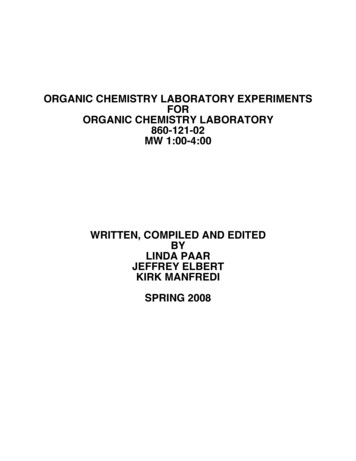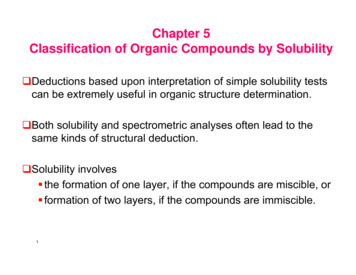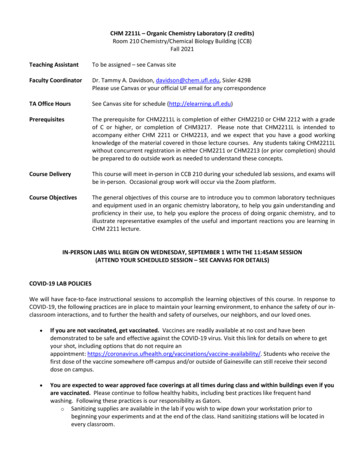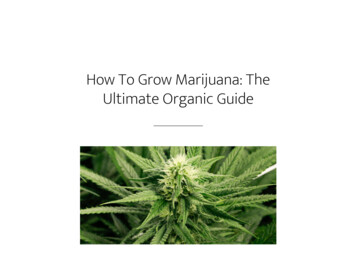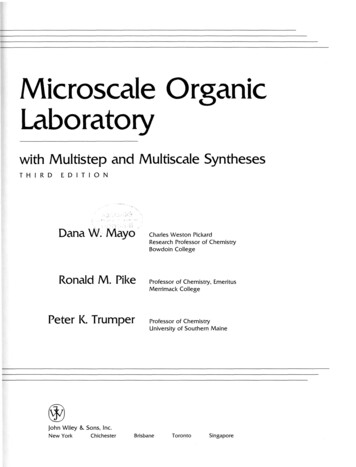
Transcription
Microscale OrganicLaboratorywith Multistep and Multiscale SynthesesTHIRDEDITION.- na . ' . - . 'Dana W. MayoRonald M. PikePeter K. TrumperJohn Wiley *L Sons, Inc.New YorkChichester, }Charles Weston PickardResearch Professor of ChemistryBowdoin CollegeProfessor of Chemistry, EmeritusMerrimack CollegeProfessor of ChemistryUniversity of Southern MaineBrisbaneTorontoSingapore
ContentsGeneral Ruies for the Microscaie LaboratoryThe Organic Chemistry Laboratory3CHAPTER 14INTRODUCTIONlMaking the Laboratory a Safer PlaceNature of HazardsReduction of RisksPrecautionary MeasuresThinking about the Risks in Using ChemicalsStorage of ChemicalsDisposal of ChemicalsMaterial Safety Data SheetsEstimating the Risks from VaporsHood UseConcluding Thoughts56677888CHAPTER2SAFETY5111313XXV
XXViCHAPTERContents3INTRODUCTION TOMICROSCALE ORGANICLABORATORY EQUIPMENTAND TECHNIQUES15CHAPTER 4DETERMINATION OFPHYSICAL PROPERTIES43CHAPTER5DEVELOPMENT OFMICROSCALE TECHNIQUES55Microglassware EquipmentStandard Experimental ApparatusHeating and Stirring ArrangementsReflux ApparatusDistillation ApparatusMoisture-Protected Reaction ApparatusSpecialized Pieces of EquipmentMicroscale LawsRules of the Trade for Handling Organic Materials at theMicroscale LevelRules for Working with Liquids at the Microscale LevelRules for Working with Solids at the Microscale LevelThe Laboratory NotebookExample of a Laboratory Notebook EntryCalculation of YieldsLIQUIDSUltramicro-Boiling PointDensityRefractive IndexSOLIDSMelting PointsMixture Melting PointsTECHNIQUE 1 Microscale Separation of Liquid Mixtures byPreparative Gas ChromatographyIntroductionProcedure for Preparative CollectionTECHNIQUE 2 Semimicroscale DistillationIntroductionDistillation TheoryTechnique 2A Simple Distillation at the Microscale LevelTechnique 2B Fractional Distillation at the SemimicroscaleLevelTECHNIQUE 3 Steam DistillationTheoryTECHNIQUE 4 Solvent ExtractionSolubilityPartition CoefficientExtractionSolid-Liquid ExtractionLiquid—Liquid 5356566061616165687171737376787880
ContentsSeparatory Funnel ExtractionContinuous Liquid-Liquid ExtractionDrying of the Wet Organic LayerSeparation of Acids and BasesSalting OutSolid-Phase ExtractionTECHNIQUE 5 CrystallizationProcedureSimple CrystallizationFiltration TechniquesUse of the Hirsch FunnelCraig Tube CrystallizationsRecrystallization PipetTECHNIQUE 6 ChromatographyTechnique 6A Column, High-Performance Liquid, andThin-Layer ChromatographyColumn ChromatographyPacking the ColumnSample ApplicationElution of the ColumnFraction CollectionFlash ChromatographyThin-Layer ChromatographyHigh-Performance Liquid ChromatographyTechnique 6B Concentration of SolutionsDistillationEvaporation with Nitrogen GasRemoval of Solvent Under Reduced PressureTECHNIQUE 7 Collection and Control of Gaseous ProductsTECHNIQUE 8 Measurement Of Specific RotationOptical Rotation TheoryThe PolarimeterTECHNIQUE 9 SublimationSublimation TheoryIntroductionEXPERIMENT [1] Measurement of Physical PropertiesEXPERIMENT [2] The Separation of a 25 L Mixture of Heptanol(bp 153 C) and Cydohexanol (bp 160 C) by GasChromatographyEXPERIMENT [3] DistillationExperiment [3A] Simple Distillation at the SemimicroscaleLevel: Separation of Ethyl Acetate fromtrans-i,2-DibenzoylethyleneExperiment [3B] Fractional Semimicroscale Distillation:Separation of Hexane and 126132133136CHAPTER6MICROSCALE ORGANICLABORATORY EXPERIMENTS119
XXVÜiContentsExperiment [3C] Fractional Semimicroscale Distillation:Separation of 2-Methylpentane and Cyclohexane Using aSpinning Band ColumnExperiment [3D] Fractional Semimicroscale Distillation: TheSeparation of 2-Methylpentane and Cyclohexane Using aSpinning Band in a Hickman-Hinkle StillEXPERIMENT [4] Solvent ExtractionExperiment [4A] Determination of a Partition Coefficient forthe System Benzoic Acid, Methylene Chloride, and WaterExperiment [4B] Solvent Extraction I: The System; BenzoicAcid, Methylene Chloride, and 10% Sodium BicarbonateSolution; An Example of Acid-Base Extraction TechniquesExperiment [4C] Solvent Extraction II: A Three ComponentMixture; An Example of the Separation of an Acid, a Base,and a Neutral SubstanceEXPERIMENT [5] Reduction of Ketones Using a Metal HydrideReagent: Cyclohexanol and eis- andfrans-4-tert-ButylcyclohexanolExperiment [5A] CyclohexanolExperiment [5B] eis- and trans-4-tert-ButylcyclohexanolEXPERIMENT [6] Photochemical Isomerization of an Alkene:c/s-1,2-DibenzoylethyleneExperiment [6A] Purification of frans-1,2-DibenzoylethyleneExperiment [6B] Isomerization of an Alkene: Thin-LayerChromatographie AnalysisExperiment [6C] Isomerization of an Alkene: NuclearMagnetic Resonance AnalysisEXPERIMENT [7] The Cannizzaro Reaction with4-Chlorobenzaldehyde: 4-Chlorobenzoic Acid and4-ChlorobenzyI AlcoholEXPERIMENT [8] The Esterification Reaction: Ethyl Laurate,Isopentyl Acetate, and the Ilse of Acidic ResinsExperiment [8A] Ethyl LaurateExperiment [8B] Isopentyl AcetateSemimicroscale PreparationExperiment [8C] Esterification by Acidic ResinsSemimicroscale PreparationsEXPERIMENT [9] The EI Elimination Reaction: Dehydration of2-Butanol to Yieid 1-Butene, frans-2-Butene, andc/s-2-ButeneEXPERIMENT [10] The E2 Elimination Reaction:Dehydrohaiogenation of 2-Bromobutane to Yield1-Butene, frans-2-Butene, and c/s-2-ButeneEXPERIMENT [11] The Isolation of Natural ProductsExperiment [IIA] Isolation and Characterization of anOptically Active Natural Product: Usnic AcidExperiment [IIB] Isolation and Characterization of a NaturalProduct: Caffeine and Caffeine 5-NitrosalicylateExperiment [ 11C] Isolation of a Natural Product by SteamDistillation: Cinnamaldehyde from CinnamonEXPERIMENT [12] Reductive Catalytic Hydrogenation of anAlkene: 0202203207210219226226232241246
EXPERIMENT [13] Hydroboration-Oxidation of an Alkene:OctanolEXPERIMENT [ 14] Diels-Alder Reaction:4-Cyclohexene-c/s-l,2-dicarboxyIic Acid AnhydrideOptional Semimicroscale PreparationEXPERIMENT [15] Diels-Alder Reaction:9,10-Dihydroanthracene-9,10-a,/3-sucdnic AcidAnhydrideOptional Semimicroscale and Macroseale PreparationsEXPERIMENT [16] Grignard Reaction with a Ketone:TriphenylmethanolEXPERIMENT [ 17] Grignard Reaction with an Aldehyde:4-Methyl-3-heptanolEXPERIMENT [18] The Perkin Reaction: Condensation ofRhodanine with an Aromatic Aldehyde to Yieldo-Chlorobenzylidene RhodanineOptional Semimicroscale PreparationEXPERIMENT [19] Alkene Preparation by the Wittig Reaction:(f)-Stilbene; 1 -MethyIene-4-ferf-butylcyclohexane; andfr«uis-9-(2-Phenylethenyl)anthraceneExperiment [ 19A] ( )-Stilbene by the "Instant Ylide" MethodExperiment [19B] ( )-Stilbene by the Homer-WadsworthEmmons ReactionExperiment [ 19C] Methylene-4-rerf-butylcyclohexaneExperiment [ 19D] frans-9-(2-Phenylethenyl)anthraceneEXPERIMENT [20] Aldo! Reaction: DibenzalacetoneOptional Semimicroscale PreparationEXPERIMENT [21 ] Quantitative Analysis of Grignard Reagents:1 -Methylbutylmagnesium Bromide and PhenylmagnesiumBromidePart 1 1 -Methylbutylmagnesium BromidePart 2 Phenylmagnesium BromideEXPERIMENT [22] Williamson Synthesis of Ethers: Propyl p-TolylEther and Methyl p-Ethylphenyl EtherExperiment [22A] Propyl p-Tolyl EtherOptional Macroseale PreparationExperiment [22B] Methyl p-Ethylphenyl EtherOptional Semimicroscale and Macroseale PreparationsEXPERIMENT [23] Amide Synthesis: Acetanilide andJV,iV'-Diacetyl-1,4-phenylenediamineExperiment [23A] AcetanilideOptional Semimicroscale PreparationExperiment [23B] N,N'-Diacetyl-1,4-phenylenediamineEXPERIMENT [24] Imide Synthesis: N-PhenylmaleimideExperiment [24A] Maleanilic AcidExperiment [24B] N-PhenylmaleimideEXPERIMENT [25] Synthesis of Cyclic Carboxylic AcidAnhydrides: Succinic Anhydride and Phthalic AnhydrideExperiment [25A] Succinic AnhydrideExperiment [25B] Phthalic AnhydrideEXPERIMENT [26] Diazonium Coupling Reaction: Methyl 5327331339342344347349351353355356358
ContentsEXPERIMENT [27] Friedel-Crafts Acylation: Acetylferrocene andDiacetylferroceneEXPERIMENT [28] Halogenation: Electrophilic AromaticSubstitution to Yield 4-BromoacetaniiideEXPERIMENT [29] Nitration: 2,5-Dichloronitrobenzene;N,N' salicylic Acid; and 2- and 4-NitrophenolSemimicroscale Preparation of Anhydrous Nitric AcidExperiment [29A] 2,5-DichloronitrobenzeneExperiment [29B] riment [29C] 5-Nitrosalicylic AcidExperiment [29D] 2- and 4-NitrophenolEXPERIMENT [30] Nucleophilic Aromatic T [31 ] Halogenation Using JV-Bromosucdnimide:9-BromoanthraceneEXPERIMENT [32] Hypochlorite Oxidation of an Alcohol:CyclohexanoneEXPERIMENT [33] Chromium Trioxide-Resin Oxidation of anAlcohol: 9-Fluorenone; Conversion to the2,4-DinitrophenylhydrazoneExperiment [33A] 9-FluorenoneExperiment [33B] 9-Fluorenone 2,4-DinitrophenylhydrazoneEXPERIMENT [34] Hypochlorite Oxidation of Methyl Ketones bythe Haloform Reaction: Benzoic Acid andp-Methoxybenzoic AcidExperiment [34A] Benzoic AcidExperiment [34B] p-Methoxybenzoic AcidOptional Semimicroscale PreparationEXPERIMENT [35] Photochemical Isomerization: c/s-AzobenzeneCHAFTER7ADVANCED MICROSCALEORGANIC LABORATORYEXPERIMENTS415IntroductionEXPERIMENT [l a d v ] Diborane Reductions: Thioxanthene andXantheneExperiment [ 1 Aadv] ThioxantheneExperiment [ 1 Badv] XantheneEXPERIMENT [2 adv ] Heterocyclic Ring Synthesis: BenzimidazoleEXPERIMENT [3 adv ] Heterocyclic Ring Synthesis:4-Hydroxycoumarin and DicoumarolExperiment [3Aadv] 4-HydroxycoumarinExperiment [3Badv] DicoumarolEXPERIMENT [4adv] Grignard and Aryl Halide Cross-CouplingReaction: l-Methyl-2-(methyl-d3)-benzeneEXPERIMENT [5adv] Oxidative Coupling of 2-Naphthol:l,i'-BI-2 NaphtholEXPERIMENT [6 adv ] Beckmann Rearrangement: 403405407408411415416419420425428431433435442446
ContentsEXPERIMENT [7 adv ] Preparation of an Enol Acetate:ChoIesta 3,5-dien-3-ol AcetateIntroductionSEQUENCE A The Synthesis of HexaphenylbenzeneExperiment [Al a ] The Benzoin Condensation ofBenzaldehyde: BenzoinSemimicroscale Preparation and Optional MicroscalePreparationsExperiment [A2a] Copper(II) Ion Oxidation of Benzoin: BenzilSemimicroscale Preparation and Optional MicroscalePreparationExperiment [A3a] TetraphenylcyclopentadienoneOptional Microscale PreparationExperiment [AI b ] ( )-StilbeneSemimicroscale PreparationExperiment [A2b] Bromination of (E)-Stilbene: meso-StilbeneDibromideSemimicroscale Preparation and Optional Macroseale andMicroscale PreparationsExperiment [A3b] Dehydrohalogenation of meso-StilbeneDibromide: DiphenylacetyleneSemimicroscale Preparation and Optional Macroseale andMicroscale PreparationsExperiment [A4ab] HexaphenylbenzeneSEQUENCE B The Stepwise Synthesis of Nylon-6,6Experiment [B1 ] Oxidation of Cyclohexanol: Adipic AcidMacroseale PreparationExperiment [B2] Preparation of an Acid Chloride: AdipoylChlorideSemimicroscale PreparationExperiment [B3] Preparation of a Polyamide: Nylon-6,6SEQUENCE C The Synthesis of SulfanilamideExperiment [C1 ] Acetylation of Aniline:2,2,2-TrifluoroacetanilideSemimicroscale PreparationExperiment [C2] Chlorosulfonation )benzenesulfonyl ChlorideSemimicroscale PreparationExperiment [C3] Preparation of an Arene Sulfonamide:SulfanilamideSemimicroscale PreparationSEQUENCE D The Synthesis of 2 -BromostyreneExperiment [DI ] The Verley-Doebner Modifcation of theKnoevenagel Reaction: frans-Cinnamic AcidSemimicroscale PreparationExperiment [D2] Bromination of frans-Cinnamic Acid:e/yf/7ro-2,3-Dibromo-3-phenylpropanoic AcidSemimicroscale 9502505507508512515518521525CHAPTER 8S E Q U E N T I A L SYNTHESES:THE TRANSITION FROMMACRO TO MICRO
XXXIIContentsExperiment [D3] An Elimination Reacton withe/yf/iro-2,3-Dibromo-3-phenylpropanoic Acid:2'-BromostyreneSemimicroscale PreparationSEQUENCE E The Synthesis of Piperonylonitrile from PiperonylAlcoholExperiment [El] PiperonalMacroseale Preparation and Optional MicroscalePreparationsExperiment [E2] Piperonal 0-(2,4-Dinitrophenyl)oximeSemimicroscale Preparation and Optional MicroscalePreparationExperiment [E3] PiperonylonitrileSEQUENCE F Introduction of Photochromism: The Synthesis of aPhotochromic ImineExperiment [Fl] An Aldol Reaction: frar?s-4-NitrochalconeSemimicroscale PreparationExperiment [F2] Semimicroscale PreparationExperiment [F3] oscale PreparationExperiment [F4] A Photochromic lmine: abicyclo[3.1.0]hex-3-eneCHAPTER 9SPECTROSCOPICIDENTIFICATION OFORGANIC COMPOUNDS585INTRODUCTION TO INFRARED SPECTROSCOPYMolecular EnergyMolecular VibrationsQuantized Vibrational EnergySelection RulesThe Case of WaterThe Case of Carbon DioxideVibrational CouplingCoupled OscillatorsSecond-Order CouplingINTRODUCTION TO GROUP FREQUENCIES: Interpretation ofInfrared SpectraGroup Frequencies of the HydrocarbonsCharacteristic Group Frequencies of AlkanesCharacteristic Group Frequencies of AlkenesCharacteristic Group Frequencies of AlkynesCharacteristic Group Frequencies of ArenesGroup Frequencies of the Phenyl GroupFactors Affecting Carbonyl Group FrequenciesMass EffectsGeometrie EffectsElectronic Effects (Resonance and Inductive)Interaction 609
ContentsCharacteristic Frequencies of Functional GroupsStrategies for Interpreting lnfrared SpectraINFRARED SPECTROSCOPY: Instrumentation and Sample HandlingInstrumentationSample Handling in the lnfraredLiquid SamplesSolution Spectra and Spectra of Materials Boiling Below 100 CSolid SamplesNUCLEAR MAGNETIC RESONANCE SPECTROSCOPY:Introduction to Nuclear Magnetic Resonance613629630631634634635635Nuclear Spin644644Instrumentation645Chemical Shift647Spin-Spin Coupling648Intensities652Second-Order Effects652INTERPRETATION OF 'H NMR SPECTRA653'H Chemical Shifts655Spin-Spin Coupling656Geminal Coupling657Vicinal Coupling657Long-Range Coupling658Examples of Complex, Yet First-Order, Coupling,3658Ethyl Vinyl Ether658Allyl Acetate660C NMR SPECTROSCOPYXXXIII663TWO-DIMENSIONAL NUCLEAR MAGNETIC RESONANCESPECTROSCOPY669NUCLEAR MAGNETIC RESONANCE SPECTROSCOPY SAMPLING671ULTRAVIOLET-VISIBLE SPECTROSCOPY: Introduction toAbsorption Spectroscopy676UV-VS Spectroscopy678Applications to Organic Molecules679Instrumentation688Sample Preparation690ORGANIC QUALITATIVE ANALYSISPreliminary TestsSeparation of ImpuritesDetection of Elements Other Than Carbon, Hydrogen, and OxygenSolubility CharacteristicsThe Classification TestsPREPARATION OF DERIVATIVESCarboxylic AcidsAlcoholsAldehydes and Ketones693695698698702704718718720721CHAPTER 1 0QUALITATIVEIDENTIFICATION OFORGANIC C O M P O U N D S693
xxxivContentsAminesAcid Chlorides and AnhydridesAromatic HydrocarbonsNitrilesPhenolsAliphatic Hydrocarbons, Halogenated Hydrocarbons, Amides, NitroCompounds, Ethers, and EstersAPPENDIXATABLES OF DERIVATIVES729APPENDIX BCHAFTERS 6, 7 AND 8:EXPERIMENTS CLASSIFIEDBY MECHANISM743GLOSSARY751INDEX755722723724724724725
Microscale Organic Laboratory with Multistep and Multiscale Syntheses THIRD EDITION .- na . . ' . - ' ,} Dana W. Mayo Charles Weston Pickard Research Professor of Chemistry Bowdoin College Ronald M. Pike Professor of Chemistry, Emeritus

